Single-family detached home
This article needs additional citations for verification. (December 2009) |
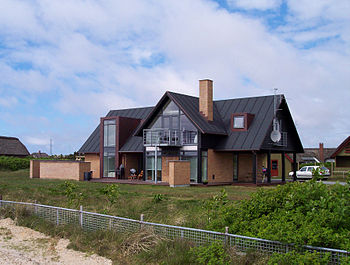
A single-family detached home, also called a single-detached dwelling, single-family residence (SFR) or separate house is a free-standing residential building. It is defined in opposition to a
Definitions
A single detached dwelling contains only one dwelling unit and is completely separated by open space on all sides from any other structure, except its own garage or shed.
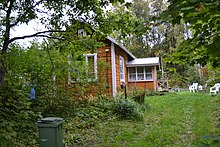
The definition of this type of house may vary between legal jurisdictions or statistical agencies. The definition, however, generally includes two elements:
- Single-family (home, house, or dwelling) means that the building is usually occupied by just one condominia.
- Detached (house, home, or dwelling) means that the building does not share walls with other houses. This excludes duplexes, triplexes, fourplexes, or linked houses, as well as all terraced houses and most especially tower blocks which can hold hundreds of families in a single building.
Most single-family homes are built on
Regional terminologies
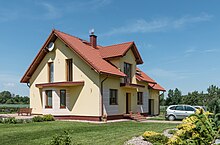

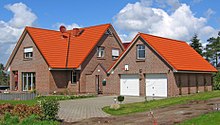
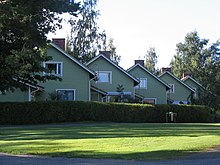
Terms corresponding to a single-family detached home in common use are single-family home (in the US and Canada), single-detached dwelling (in Canada), detached house (in the United Kingdom and Canada), and separate house (in New Zealand).[citation needed]
In the United Kingdom, the term single-family home is almost unknown, except through Internet exposure to US media. Whereas in the US, housing is commonly divided into "single-family homes", "
History and distribution
In pre-industrial societies, most people lived in multi-family dwellings for most of their lives. A child lived with their parents from birth until marriage and then generally moved in with the parents of the man (
The idea of a
Single-family homes are now common in rural and suburban and even some urban areas across the New World and
In the 21st century, a lack of
Separating types of homes
House types include:
- verandahacross its front. In the UK and Ireland, any small, old (especially pre-World War I) house in a rural or formerly rural location, whether with one, two, or (rarely) three stories, is a cottage.
- Bungalow, in American English, this term describes a medium- to large-sized freestanding house on a generous block in the suburbs, with a generally less formal floor plan than a villa. Some rooms in a bungalow typically have doors that link them together. Bungalows may feature a flat roof. In British English, it refers to any single-storey house (much rarer in the UK than in the US).
- Villa, a term originating from Roman times when it was used to refer to a large house which one might retreat to in the country. In the late 19th and early 20th centuries, villa suggested a freestanding comfortable-sized house on a large block, generally found in the suburbs. In Victorian terraced housing, a villa was a house larger than the average byelaw terraced house, often having double street frontage.
- Mansion, a very large, luxurious house, typically associated with exceptional wealth or aristocracy, usually of more than one story, on a large block of land or estate.
Mansions usually will have many more rooms and bedrooms than a typical single-family home, including specialty rooms, such as a library, study, conservatory, theater, greenhouse, infinity pool, bowling alley, or server room.
Many mansions are too large to be maintained solely by the owner, and there will be maintenance staff. This staff may also live on-site in 'servant quarters'. - Palace, a particularly grand mansion, usually the home of a high ranking government official like a country's ruler.
- Castle, a medieval European or feudal Japanese fortified dwelling formerly occupied by a lord and his family. The term castle can also refer to a house or mansion with some of the architectural characteristics of medieval castles.
See also
References
- ^ "Spending Patterns in Canada: Data quality, concepts and methodology: Definitions". www.statcan.gc.ca.
- ^ “Saitta House – Report Part 1 Archived 2008-12-16 at the Wayback Machine”,DykerHeightsCivicAssociation.com
- ^ Canada, Government of Canada, Statistics. "Statistics Canada: 2006 Community Profiles". www12.statcan.ca.
{{cite web}}: CS1 maint: multiple names: authors list (link) - ^ a b Dillon, Liam (May 13, 2019). "California could bring radical change to single-family home neighborhoods". Los Angeles Times. Retrieved 2019-05-13.
- ^ "The Upzoning Wave Finally Catches Up to California". Bloomberg.com. 1 March 2021. Retrieved 2 March 2021.
External links
- "Australian Housing Types" (PDF). Your House teacher resource kit. Royal Australian Institute of Architects. Archived from the original (PDF) on 2006-06-26. Retrieved 15 January 2006.
